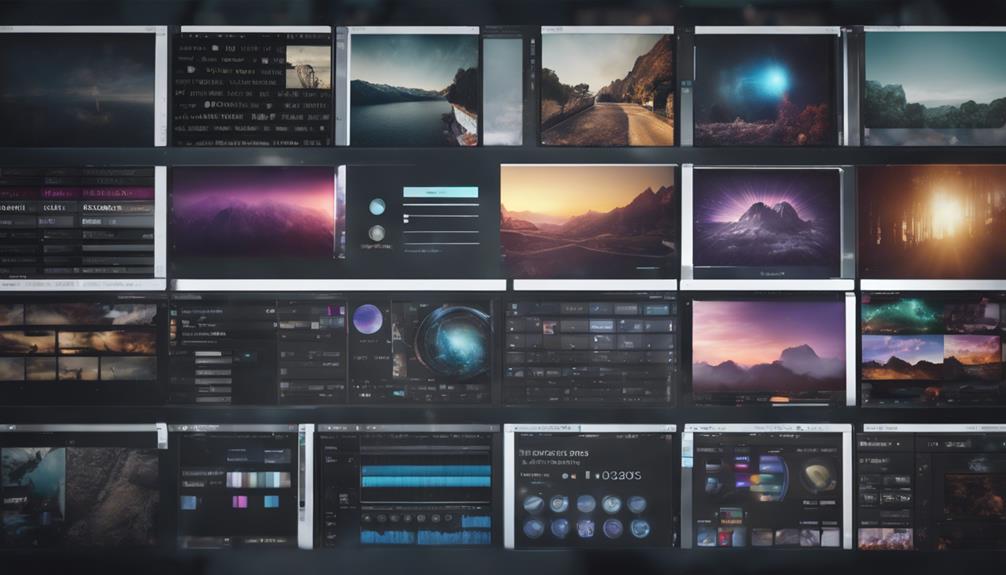Did you know that video data is expected to account for 82% of global internet traffic by 2022? As you explore the realm of video data processing, you’ll encounter a diverse array of leading services for video data processing designed to enhance, edit, and optimize your video content. From advanced compression algorithms to high-resolution scaling techniques, these services offer a wide range of capabilities to transform your videos into professional-grade productions. So, which services are at the forefront of this evolving landscape, and how can they elevate your video processing endeavors?
Video Compression Algorithms
Video compression algorithms play a crucial role in reducing the size of video files while maintaining quality. By employing various techniques such as removing redundant data and optimizing encoding, these algorithms help in efficient data storage and transmission of video content. The balance between achieving smaller file sizes for storage and ensuring high video quality is a delicate one that these algorithms strive to maintain.
When discussing video quality, it is essential to consider how compression affects it. While reducing file sizes is crucial for optimizing data storage, excessive compression can lead to a decrease in video quality. Finding the right balance between compression ratios and preserving video quality is a key focus of video compression algorithms.
Efficient data storage is another significant advantage of using video compression algorithms. By reducing the size of video files, these algorithms enable users to store more content without compromising on video quality. This optimization in data storage allows for better utilization of resources and smoother video processing.
Frame Rate Conversion
You will explore the fundamental aspects of frame rates, various techniques for converting them, and how these conversions are applied across different industries. Understanding frame rate basics is crucial for grasping the intricacies of video processing. By delving into conversion methods and real-world applications, you can gain insights into optimizing video data processing workflows.
Frame Rate Basics
Understanding frame rate basics is essential when it comes to frame rate conversion in video data processing. Frame rate optimization plays a crucial role in video quality improvement, directly impacting viewer experience. The frame rate refers to the number of individual frames or images that are displayed per second in a video. A higher frame rate typically results in smoother motion and a more lifelike appearance, enhancing the overall viewing experience. On the other hand, a lower frame rate may lead to choppy or stuttering visuals, reducing the quality of the video and potentially affecting viewer engagement.
Conversion Techniques
When it comes to video data processing, one must consider various conversion techniques, particularly focusing on frame rate conversion for optimal viewer experience. Frame rate conversion plays a crucial role in ensuring smooth playback and high-quality video output. Here are some key aspects to consider in frame rate conversion:
- Quality Enhancement: Frame rate conversion is essential for improving the overall quality of videos by ensuring consistency and smoothness in motion sequences.
- Data Analysis: Utilizing data analysis techniques can help in determining the most suitable frame rate conversion methods based on the specific requirements of the video content.
- Data Visualization and Machine Learning: Incorporating data visualization tools and machine learning algorithms can aid in the automation of frame rate conversion processes, leading to more efficient and accurate results.
Industry Applications
Utilizing advanced frame rate conversion techniques in various industries enhances video quality and ensures seamless playback for an optimal viewing experience. Industry trends indicate a growing demand for high-quality video content across sectors such as entertainment, broadcasting, sports, and gaming. Case studies have shown that implementing efficient frame rate conversion solutions has led to improved viewer engagement and satisfaction.
Emerging technologies in frame rate conversion, such as motion-compensated frame interpolation and artificial intelligence algorithms, are revolutionizing the way videos are processed and displayed. These innovations enable smoother transitions between frames, reducing motion blur and enhancing overall visual appeal.
Looking ahead, the future prospects for frame rate conversion in industries are promising. With the continuous advancement of technology, we can expect even more sophisticated algorithms and tools to further enhance video quality and optimize viewing experiences. By staying informed about the latest developments in frame rate conversion, industries can stay ahead of the curve and deliver top-notch video content to their audiences.
Resolution Scaling
Scaling the resolution of video data is a fundamental process in optimizing the quality and compatibility of media content across various platforms. When it comes to resolution scaling, understanding the upscaling techniques and quality enhancement methods is crucial for achieving the best results. Here are three key points to consider:
- Bicubic Interpolation: This technique is commonly used for upscaling images and videos. It calculates new pixel values by considering the average of the surrounding pixels, resulting in smoother transitions and reduced artifacts.
- Deep Learning-Based Upscaling: Leveraging artificial intelligence and neural networks, deep learning algorithms can enhance the quality of upscaled content by predicting and generating realistic details that were not present in the original data.
- Adaptive Resolution Scaling: This approach dynamically adjusts the resolution based on the display capabilities of the target device, ensuring optimal viewing experience while conserving bandwidth and processing power.
File Format Conversion
Converting video data from one file format to another is a critical process that ensures compatibility and accessibility across different platforms and devices. When engaging in file format conversion, it is essential to consider quality enhancement. This involves maintaining or even improving the quality of the video during the conversion process to ensure a seamless viewing experience. By optimizing parameters such as resolution, bitrate, and codec settings, the converted video can retain its original clarity or be enhanced for better visual appeal.
Moreover, file format conversion plays a vital role in data visualization. Different platforms and devices support specific file formats for displaying video content. By converting video data into formats compatible with various visualization tools, you can effectively present information, statistics, or other visual elements in a clear and accessible manner. This facilitates better understanding and interpretation of the data presented, enhancing overall communication and engagement.
Noise Reduction
You can enhance the quality of your video data by utilizing advanced noise filtering techniques. Real-time noise removal capabilities allow for immediate improvement in the audio-visual output. Customizable noise reduction options provide flexibility to tailor the processing to your specific needs.
Advanced Noise Filtering
Utilizing cutting-edge algorithms, our advanced noise filtering technology significantly enhances the quality of video data by reducing unwanted distortions and imperfections. By integrating machine learning and artificial intelligence techniques, our system can intelligently identify and eliminate various types of noise from video streams, ensuring a cleaner and more polished final output. Here’s how our advanced noise filtering stands out:
- Adaptive Filtering: Our technology dynamically adjusts filter settings based on the characteristics of the noise present, allowing for precise noise reduction tailored to each specific scenario.
- Temporal Noise Reduction: Through sophisticated temporal analysis, our system can effectively reduce noise that varies over time, such as flicker or random fluctuations, maintaining video clarity and consistency.
- Spatial Noise Suppression: Leveraging advanced spatial filtering methods, our technology targets noise that appears as artifacts or inconsistencies in different areas of the frame, resulting in a cleaner and more visually appealing video output.
Real-Time Noise Removal
Implementing real-time noise removal in video data processing systems enhances the quality of live streams by minimizing unwanted distortions and imperfections on the fly. Real-time noise detection plays a crucial role in identifying and reducing unwanted noise during live video processing. Image enhancement techniques are utilized to improve the visual quality by removing noise artifacts in real-time.
Noise removal algorithms are essential components in real-time noise reduction. These algorithms work by analyzing the video stream, identifying noise patterns, and applying filters to eliminate them. Deep learning approaches have shown promising results in real-time noise removal by training models to differentiate between noise and actual content, allowing for more accurate noise reduction without compromising image quality.
Customizable Noise Reduction
Customizable noise reduction in video data processing systems allows for tailored adjustments to noise filtering parameters, offering flexibility in optimizing noise reduction based on specific video content requirements. By leveraging AI-powered filtering and customizable presets, users can achieve enhanced noise reduction outcomes. Machine learning plays a crucial role in adaptive processing, enabling the system to continuously learn and improve its noise reduction capabilities over time. Here are three key aspects of customizable noise reduction:
- AI-Powered Filtering: Utilizing artificial intelligence algorithms, the system can intelligently identify and suppress noise in varying environments, ensuring high-quality video output.
- Customizable Presets: Users can save and apply customized noise reduction settings for different types of videos, streamlining the process and enhancing efficiency.
- Machine Learning for Adaptive Processing: Through continuous learning, the system adapts its noise reduction techniques based on feedback, resulting in more accurate noise reduction tailored to specific video content.
Color Correction
How can color correction enhance the visual quality of your video data? Color correction plays a crucial role in refining the colors and overall look of your video content. By utilizing advanced color grading techniques and video restoration processes, you can achieve a more polished and professional appearance. Color correction software and color grading tools offer a wide range of options to adjust color balance, contrast, saturation, and brightness, allowing you to create a consistent and appealing visual style throughout your video project.
Through color correction, you can correct any color inconsistencies, enhance the mood and atmosphere of your footage, and ensure a seamless visual flow from scene to scene. This process is essential for maintaining the integrity of your video data and delivering a high-quality viewing experience to your audience. By investing time and effort into precise color correction, you can elevate the overall impact of your video content and captivate your viewers with stunning visuals.
Motion Estimation
To optimize the smoothness and quality of your video data, motion estimation techniques are utilized to analyze and predict the movement of objects within frames. This process is crucial for maintaining video clarity and reducing artifacts. Let’s delve into the world of motion estimation:
- Motion Estimation Techniques
- Block Matching Algorithms
- Optical Flow Methods
- Phase Correlation Techniques
- Motion Estimation Challenges
- Computational Complexity
- Accurate Motion Vector Prediction
- Handling Occlusions and Disocclusions
- Motion Estimation Benefits
- Enhances Video Compression Efficiency
- Improves Video Quality
- Enables Advanced Video Editing Capabilities
Achieving high motion estimation accuracy is essential for preserving video fidelity. Despite facing challenges like computational intensity and occlusion handling, the benefits of motion estimation, such as improved compression efficiency and enhanced video quality, make it a critical aspect of video data processing.
Deinterlacing
You need to understand the essence of deinterlacing for optimal video processing. Choosing the best deinterlacing software is crucial for achieving high-quality results. Implementing deinterlacing tips and tricks can significantly enhance the overall viewing experience of your videos.
Deinterlacing Explained Simply
Deinterlacing is the process of converting interlaced video into a progressive format for smoother playback and improved visual quality. When dealing with deinterlacing techniques, it’s essential to understand how this conversion takes place. Here are three key points to consider:
- Bob Deinterlacing: This technique duplicates each field to create a full frame, resulting in smoother motion but potential loss of image sharpness.
- Weave Deinterlacing: Weave combines two interlaced fields into a single frame, which can lead to combing artifacts but maintains better image quality.
- Motion-Adaptive Deinterlacing: This advanced method analyzes moving objects to deinterlace only where necessary, preserving detail and reducing artifacts.
When comparing deinterlacing software, factors like algorithm efficiency, artifact reduction capabilities, and compatibility with different video formats should be considered. Understanding these deinterlacing techniques and software variances is crucial for achieving optimal video quality in your processing workflows.
Best Deinterlacing Software
Understanding the nuances of deinterlacing software is key to optimizing video quality in your processing workflows. When choosing the best deinterlacing software for your needs, it is crucial to consider its ability to effectively remove interlacing artifacts. These artifacts can result in jagged edges and motion blur in your videos if not addressed correctly.
In a deinterlacing software comparison, factors such as processing speed, effectiveness in artifact removal, and compatibility with various video formats should be taken into account. Popular deinterlacing software options include HandBrake, VLC Media Player, and Aiseesoft Video Converter Ultimate. Each of these tools offers unique features and performance levels when it comes to deinterlacing videos.
Deinterlacing Tips and Tricks
To enhance the quality of your video processing workflows, mastering effective deinterlacing techniques is essential. When dealing with interlaced video content, understanding how to properly deinterlace is crucial to ensure a seamless viewing experience. Here are some tips and tricks to help you refine your deinterlacing process:
- Choose the Right Method: Selecting the appropriate deinterlacing method based on the content’s characteristics is key. Options like Bob, Weave, and Motion-Adaptive deinterlacing can help mitigate deinterlacing artifacts and enhance the overall video quality.
- Adjust Deinterlacing Settings: Fine-tuning parameters such as field order, edge processing, and motion detection can significantly impact the deinterlacing results. Experiment with these settings to find the optimal configuration for your specific needs.
- Inspect for Artifacts: Keep an eye out for deinterlacing artifacts like combing or jagged edges, which can detract from the viewing experience. Regularly scrutinizing the output for such imperfections allows for timely adjustments and improvements in your deinterlacing workflow.
Bit Rate Reduction
Consider implementing compression techniques to reduce the bit rate of your video data for more efficient storage and transmission. By reducing the bit rate, you can effectively manage your data while maintaining acceptable video quality. Bit rate reduction is crucial for optimizing storage space and ensuring smoother transmission of video files over networks.
When it comes to video quality, it’s essential to strike a balance between compression and maintaining the necessary level of detail. Various compression algorithms like H.264 or HEVC offer efficient ways to reduce bit rate without significantly compromising video quality. These techniques enable you to manage your data effectively without sacrificing the viewing experience.
Effective data management is key in video processing. By reducing the bit rate through compression, you can store more videos within the same storage capacity and transmit them more efficiently across different platforms. Implementing bit rate reduction strategies enhances the overall data management process, ensuring that your video files are accessible and deliver a satisfactory viewing experience while optimizing storage and transmission resources.
Image Stabilization
Implementing image stabilization techniques is crucial for enhancing the visual quality of your videos by reducing unwanted camera movements. By employing camera stabilization techniques, video editing software can help you achieve smoother footage, creating a more professional look for your content. Here are three key points to consider when addressing image stabilization in your post-production workflow:
- Utilize Optical Image Stabilization (OIS): OIS is a hardware-based stabilization method found in many cameras and lenses. It helps counteract small movements and vibrations, resulting in steadier shots.
- Explore Digital Image Stabilization (DIS): DIS is a software-based approach that can further enhance stabilization by analyzing frames and adjusting them to reduce shake and blur.
- Integrate Image Enhancement Tools: When stabilizing footage, consider using image enhancement tools within your video editing software to fine-tune the overall visual quality of your content.
Frequently Asked Questions
Can Video Data Processing Improve Facial Recognition Accuracy?
Oh, sure, video data processing can totally enhance facial recognition accuracy. By fine-tuning facial recognition algorithms through data processing, you’ll see a significant boost in accuracy rates. It’s like giving those algorithms a much-needed makeover!
How Does Video Data Processing Impact Streaming Latency?
When video data processing streamlines operations, delays reduce, enhancing viewer experience by optimizing performance. This impact on streaming latency is critical for maintaining high-quality, real-time video delivery in various applications.
Are There Legal Implications for Processing Surveillance Footage?
Privacy concerns and data protection are paramount when processing surveillance footage. Legal implications can arise if not handled correctly. Remember, safeguarding personal information is crucial. Stay informed about regulations to navigate this complex landscape effectively.
Can Video Data Processing Enhance Object Tracking in Videos?
Yes, video data processing can enhance object tracking in videos through advanced techniques like motion detection and deep learning. These methods enable accurate identification and tracing of objects, improving surveillance and analysis capabilities significantly.
What Are the Ethical Considerations in Video Data Processing?
When delving into video data processing, it’s crucial to consider ethical aspects. Data privacy is paramount, with 81% of consumers concerned about how companies handle their data. Be vigilant against algorithm bias to ensure fair outcomes.



